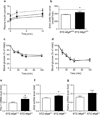Mig6 haploinsufficiency protects mice against streptozotocin-induced diabetes
- PMID: 24989997
- PMCID: PMC4156529
- DOI: 10.1007/s00125-014-3311-z
Mig6 haploinsufficiency protects mice against streptozotocin-induced diabetes
Abstract
Aims/hypothesis: EGF and gastrin co-administration reverses type 1 diabetes in rodent models. However, the failure of this to translate into a clinical treatment suggests that EGF-mediated tissue repair is a complicated process and warrants further investigation. Thus, we aimed to determine whether EGF receptor (EGFR) feedback inhibition by mitogen-inducible gene 6 protein (MIG6) limits the effectiveness of EGF therapy and promotes type 1 diabetes development.
Methods: We treated Mig6 (also known as Errfi1) haploinsufficient mice (Mig6 (+/-)) and their wild-type littermates (Mig6 (+/+)) with multiple low doses of streptozotocin (STZ), and monitored diabetes development via glucose homeostasis tests and histological analyses. We also investigated MIG6-mediated cytokine-induced desensitisation of EGFR signalling and the DNA damage repair response in 832/13 INS-1 beta cells.
Results: Whereas STZ-treated Mig6 (+/+) mice became diabetic, STZ-treated Mig6 (+/-) mice remained glucose tolerant. In addition, STZ-treated Mig6 (+/-) mice exhibited preserved circulating insulin levels following a glucose challenge. As insulin sensitivity was similar between Mig6 (+/-) and Mig6 (+/+) mice, the preserved glucose tolerance in STZ-treated Mig6 (+/-) mice probably results from preserved beta cell function. This is supported by elevated Pdx1 and Irs2 mRNA levels in islets isolated from STZ-treated Mig6 (+/-) mice. Conversely, MIG6 overexpression in isolated islets compromises glucose-stimulated insulin secretion. Studies in 832/13 cells suggested that cytokine-induced MIG6 hinders EGFR activation and inhibits DNA damage repair. STZ-treated Mig6 (+/-) mice also have increased beta cell mass recovery.
Conclusions/interpretation: Reducing Mig6 expression promotes beta cell repair and abates the development of experimental diabetes, suggesting that MIG6 may be a novel therapeutic target for preserving beta cells.
Figures









References
-
- von Herrath M, Sanda S, Herold K. Type 1 diabetes as a relapsing-remitting disease? Nat Rev Immunol. 2007;7:988–994. - PubMed
-
- Skyler JS. The year in immune intervention for type 1 diabetes. Diabetes Technol Ther. 2013;15(Suppl 1):S88–S95. - PubMed
-
- Eizirik DL, Sandler S, Palmer JP. Repair of pancreatic beta-cells. A relevant phenomenon in early IDDM? Diabetes. 1993;42:1383–1391. - PubMed
-
- Group TDCaCTR. Effect of intensive therapy on residual beta-cell function in patients with type 1 diabetes in the diabetes control and complications trial. A randomized, controlled trial. Ann Intern Med. 1998;128:517–523. - PubMed
Publication types
MeSH terms
Substances
Grants and funding
LinkOut - more resources
Full Text Sources
Other Literature Sources
Molecular Biology Databases
Research Materials
Miscellaneous

